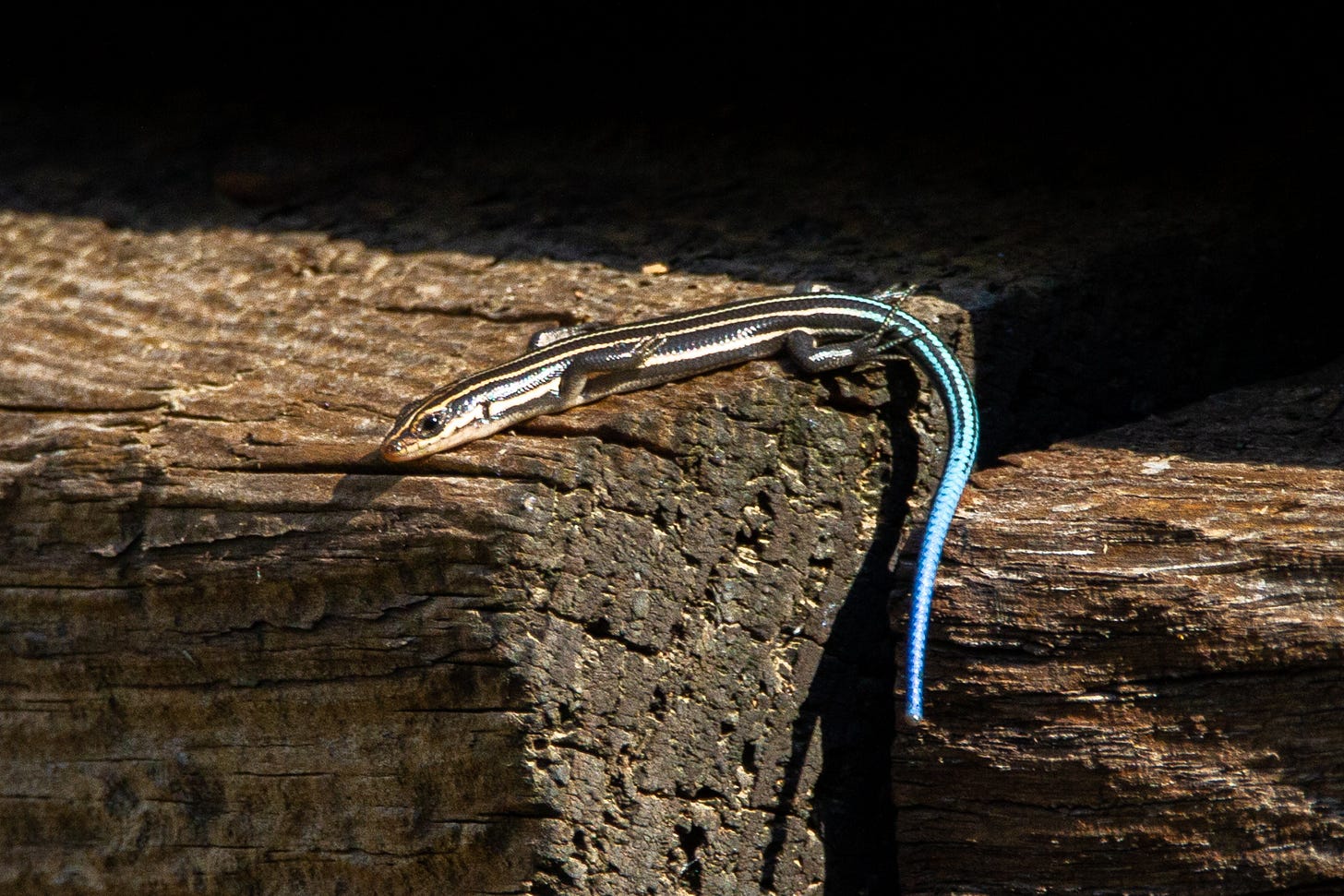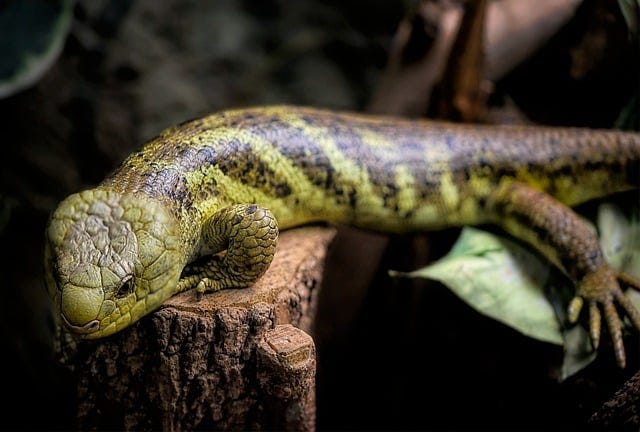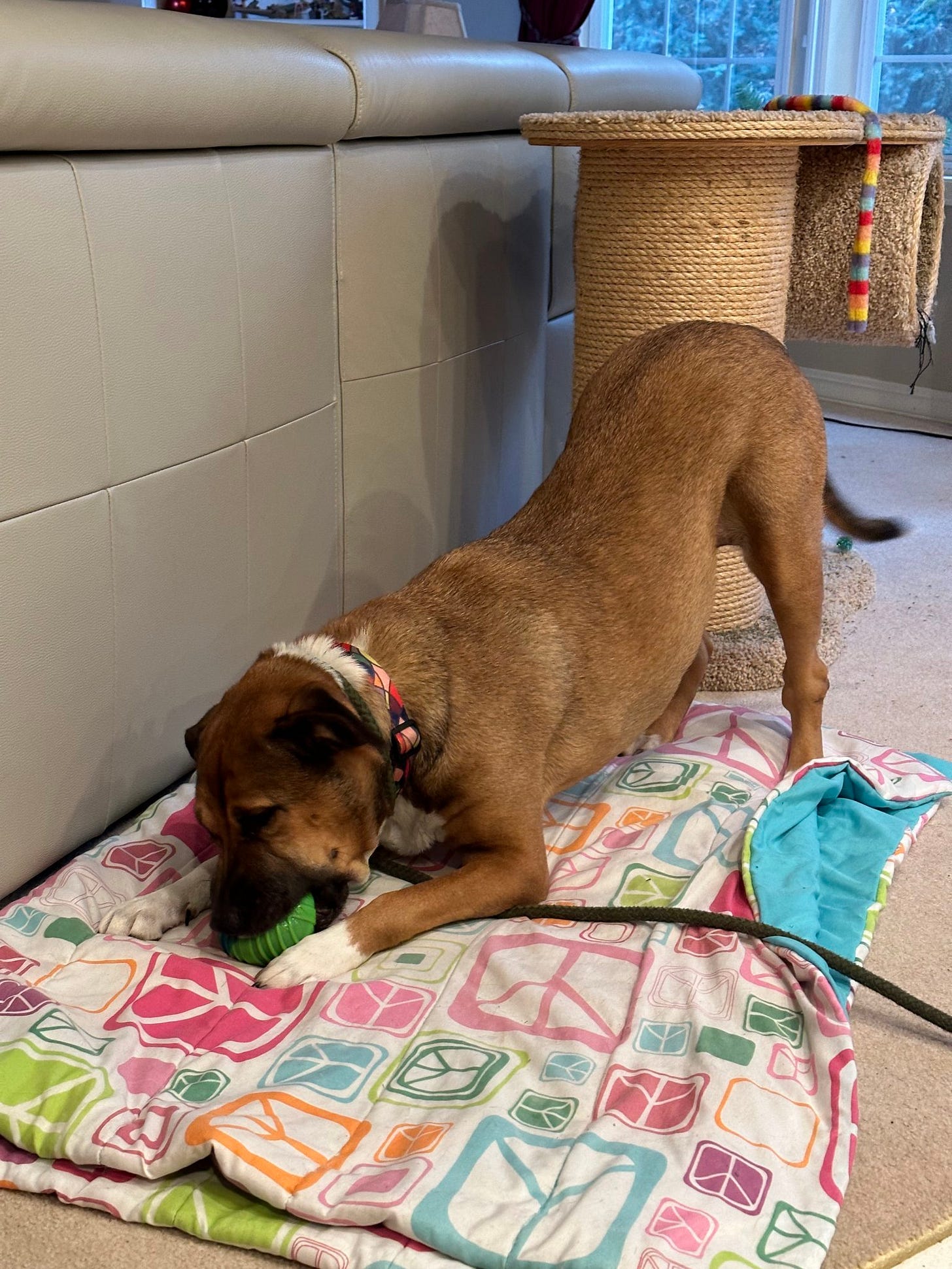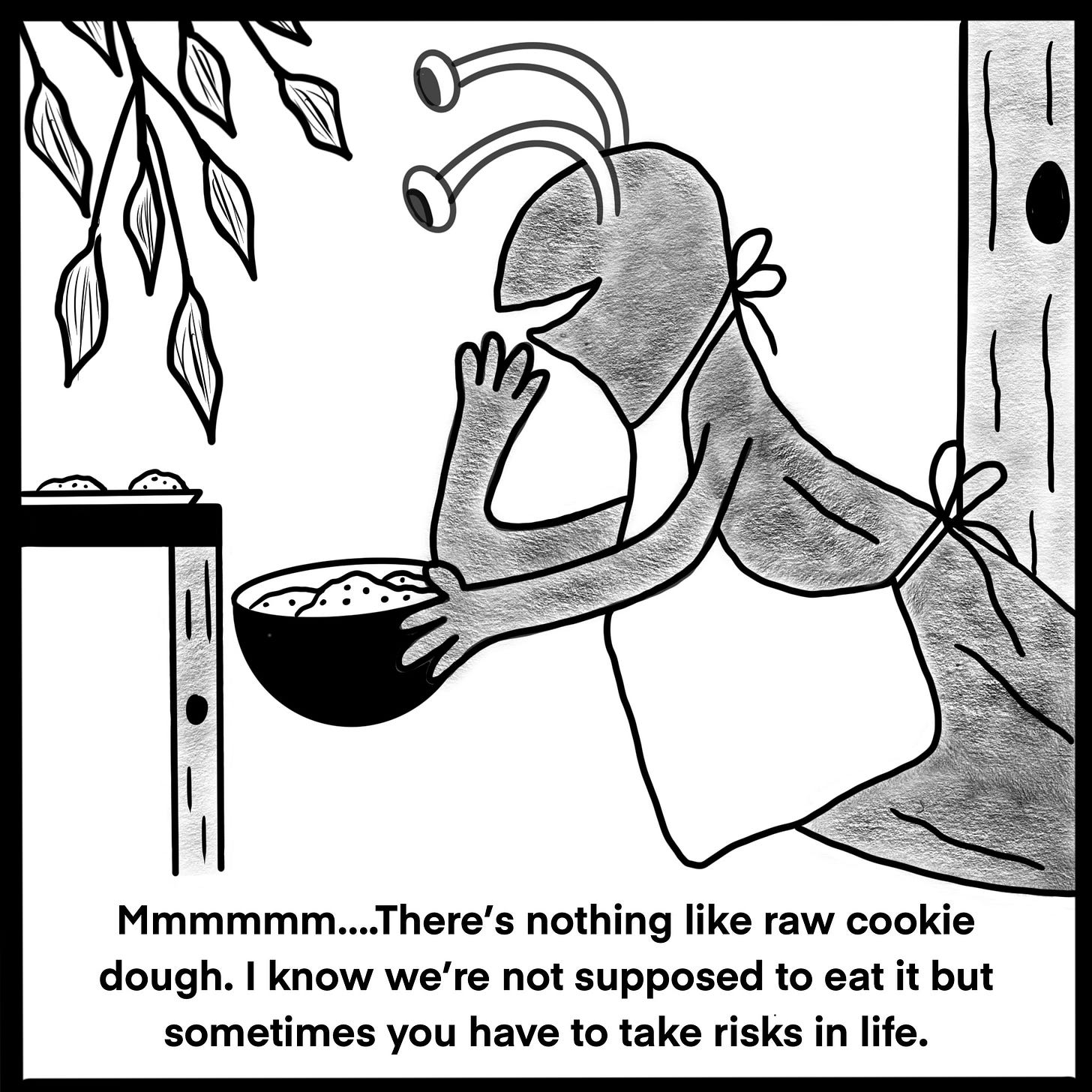Would You Recognize a Skink if You Saw One?
Greetings!
As with much of the US, we’ve been hunkered down in our house, staying out of the cold weather and off the frozen roads. We’ve had nearly daily “winter weather advisories,” which is unusual for us, but fortunately, most didn’t amount to much in our specific area. I know many have had it so much worse. We’ve been extremely fortunate. My sympathy goes out to you if you’ve not been as lucky this winter.
My son is doing pretty well with his broken foot. He goes back to the specialist in a few weeks to make sure it is healing properly. I’m proud of how well he’s been taking care of himself.
I had so much fun doing research for this week’s newsletter! I got lost wading through fascinating YouTube videos, which I don’t use as references, but will watch a bit to get a sense of the animals. I still have some saved to go back and watch once I’m done with this issue. Thank you for giving me this opportunity to learn so much just so I can share it with you.
This Week
This week, while hanging out with Kola Dog inside because it’s been too cold to be outside for more than about 15 minutes at a time, I have been thinking about dog games. Sure, there are the basic ones like fetch, Frisbee, and tug-of-war, but what about the less common ones, or even ones that are so unique only you and your dog know them?
Kola enjoys a good game of indoor fetch when we aren’t outside, but only if she is in the mood and I have the right toy. Her favorite is Piggy Friend, a small squeaky pig that she amazingly never tried to destroy. There are similar ones, Owl Friend and Gator Friend, and they are sometimes acceptable to play with. If she’s not in the mood, tossing a toy to her will result in it bouncing off her nose and not even acknowledging it. Kinda pathetic, really, but I get the message loud and clear.
One of our regular inside games is “find it.” I hide bits of treats, often pieces of carrot, around the family room while she stays in the kitchen. When I’m ready, I tell her, “find it!” and she excitedly searches the room for tasty goodies. As a result of playing this game, she has also learned “hot and cold.” You know that game you played as a kid, or maybe with your own children, where clues like warm, hot, hotter, cool, cold, and freezing were used to help the seeker find the hidden item? At this point, I believe she is simply responding to my tone of voice and not the words, but she understands the concept and always finds the treats!
Sometimes games are as much about learning as they are about having fun. Kola and I play a version of the “shell game.” I bring out three plastic cups, hide a treat under one, slowly move them around, and then ask her, “which one?” If she’s correct in nosing the treat cup, she gets to knock it down and eat the treat. If not, we start over. She tends to get too excited to focus very well, so I have reduced the number of cups to two and only switch them around once. If she’s calm enough to focus, she’ll get it right. If not, she’s got a 50% shot at getting it right by just guessing.
On and off over the past few years, we have worked on winding through three plastic cones. Again, if she is focused enough, she can do it easily. When we haven’t tried the game in a while, I’ll go back to starting with going around one cone, build up to two, and then finally all three. I really need to go back to that game because it clearly exercises her brain and she is fairly motivated to learn it, unlike with the cups, where she’s fine with just knocking them all over in search of the treat.
We have meal-time-related games, basically, enrichment activities, where I will put part of her food in an empty egg carton, cereal box, Kong Toy, or whatever else I can find. She will nose it around or rip it apart until all the kibble has been eaten. (She then has to recycle the carboard, which she is fairly skilled at.) She also gets bones and Kong Toys that have been frozen with soggy dog food and peanut butter inside. Maybe those things aren’t exactly games, but they stimulate her brain and are fun for her, so I think they count.
Thinking back on all the games we’ve played, the most fun and unique was one we played when the kids were still in elementary school, and maybe even middle school. We called it “Release the Kraken!” First, we put Kola in her crate, which is and always has been in the middle of our kitchen. It’s a beloved piece of furniture and Kola’s safe space. While she watched on, the kids would cover themselves with an old queen-size sheet - one that had already been designated for the dog. They’d take a squeaky toy with them, and tuck in all the loose sides, as much as possible. I’d help them out a bit with that part.
“Ready?” I’d ask.
“Yes,” they would both giggle.
“Release the kraken!” I’d bellow as I opened Kola’s crate.
Whoever had the toy would squeak it from underneath the sheet. Kola would enthusiastically charge out of her crate and look for a way to get to the kids. She’d shove her nose against the floor and the sheet, seeking an opening. Soon the kids were screaming and laughing hysterically, Kola joining in with playful barks. Once she found her opening, she’d slither in under the blanket, overjoyed to have found the kids, as well as her squeaky toy. We’d usually play “Release the Kraken” 3 or 4 times, until the kids were out of breath from laughing so hard.
Talk about fun family games!
Full Speed Ahead
What About…?
Skinks

Until about 5 years ago, I had no idea what a skink was. I learned of them through my daughter who had a friend with a pet skink. I asked my wife, my sister, and my brother-in-law, all well-educated, well-rounded individuals, and none of them knew what a skink is. (Shout out to my brother-in-law who went out on a limb and stated it was a creature. 😂)
It may seem odd, but at least here in the Pacific NW, I’d venture to say a majority of us couldn’t identify a member of the largest family of lizards having over 1500 known species. Yes, a skink is a type of lizard.
I fell into a rabbit hole researching skinks and lost about 4 hours. No, it wasn’t lost time, it was educational and fun. I ended up learning not only about skinks but some other reptiles and am a new subscriber to Kamp Kenan on YouTube. The channel owner is a guy with a reptile sanctuary, committed to education about and conservation of reptiles. (I’ll look into him more to make sure he is someone I want to support.)
Skinks range in size from about 3-36 inches nose to tail. Size really depends upon the species, but it seems fair to say that the average skink is somewhere in between those two extremes. They often have long, tapered tails that can measure up to 150% of the head and body length.
Skinks have shiny, smooth scales, a stout, cylindric body, a conical head, and no neck. Their heads often look very snake-like. While most have short legs with 5, 3, 2, or 1 toes, some have very small to no limbs at all, making them look even more like a snake. I’m not generally an ophidiophile (That’s the word for snake-lover - you just learned something there, I bet!), but I am rather fascinated by skinks.
Skinks have autonomy, but not in an independence kind of way. Well, maybe, but in this case it means self-amputation. Most skinks have the ability to release their tail, if needed, to escape from a predator or even to release it as a distraction for a predator. The tail will keep wiggling after detached, giving the skink time to get away. The tail will grow back over time.
Skinks can be herbivorous, carnivorous, insectivorous, or omnivorous. Most eat mainly a variety of insects. A few species are known to even eat land crabs.
There is one species of skink that has a prehensile (grasping) tail. Not surprisingly, it is named the prehensile-tailed skink, AKA the Solomon Island skink and the monkey-tailed skink. It uses its tail for climbing and lives mostly in the trees. It is the largest skink species and is thought to be the only strictly herbivorous skink.
Skink species can be found throughout the world with the exception of Antarctica. Though there are semi-aquatic, arboreal, and sand-dwelling skinks, most are ground dwellers who burrow. In cold climates, skinks hibernate in the winter.
Skinks use their tongues to detect chemical changes in the environment, similar to the way some animals use their nose. They flick it in and out of their mouths, gathering information. The blue-tongued skink has been reported to flick its tongue out up to 300 times an hour.
Exploring More

Why Blue-Tongued Skinks Have Blue Tongues and Other Bizarre Facts
Skinks have been on earth for somewhere around 170 million years. Surely, with millions of years of survival adaptations, humans should be able to learn something from them. The most obvious lessons on survival involve staying out of sight, blending with your background, and if you must be colorful, use it to warn off predators.
Skinks also reveal an evolutionary lesson in casting off unnecessary parts but bringing them back if needed. Normally, that latter part isn’t seen very often. About 62 million years ago, skinks in Southeast Asia stopped growing legs. They were not necessary for burrowing in the loose, dry soil. Later, around 40 million years ago, the area became wet and muddy. The skinks then grew their legs back so they could better move around in the slippery, muddy conditions. How’s that for adaptation?
It’s difficult to find much information on the history of skinks. For starters, with over 1500 species, that’s a lot of ground to cover. Some skinks have been studied more than others, but they don’t appear to have been involved in any significant historical events, were not especially revered or overly feared, collected or worshipped by any historical figures or celebrities, nor do they have any famous songs, movies, or cartoons involving them. It seems the entire family is vastly underrated, except among many gardeners who love that they keep the population of harmful insects low. The underrated part is unfortunate because they are quite interesting and beautiful creatures.
There is mythology involving generic lizards, rather than skinks specifically. Ancient Romans believed lizards were related to divine wisdom and good fortune. The Greeks are said to have connected them with death and resurrection. In Aboriginal mythology, lizards are associated with the natural world, and humans as related to the natural world. Many Native American traditions view lizards as good luck and are related to healing, survival, and strength. To kill a skink would be bad luck. Generally, the associations are positive, although some, such as those of various African cultures, are negative, being related to death and bad luck.
As for more recent information about skinks, one of the really unique characteristics of skinks is that various species lay eggs (oviparous), give live birth (viviparous), or do both. In 2019, University of Sydney researchers published a paper reporting both happening within the same pregnancy. This was the first time on record that this has been seen in vertebrates, so was a pretty big deal.
Other contemporary studies specifically involve the blue-tongued skink and why its tongue is blue. When a predator is near, these skinks are known to hiss, puff up their bodies, and as a last resort, open their pink mouths wide and stick out their blue tongues, which are a more vibrant blue at the back than the front. This often startles the predators and allows the skink to escape. Blue-tongued skinks have tongues that are also more UV-blue in the back, which is something that many lizards can see, although they themselves cannot. Scientists are still trying to determine if the UV qualities of the tongue are significant, and if so, how?
Studies have hypothesized that this display was biologically designed to ward off predators, which it often does, but other research seems to negate this. One study showed that blue-tongued lizards are far more likely to engage in a full tongue display when threatened by birds and foxes than other lizards. While it is uncertain what, if any, spectrum of UV light foxes can see, birds mainly see in a level lower than that reflected by the tongue of the blue-tongued skink. This means the UV-blue is probably not significant as a deterrent from birds. However, birds are fairly likely to startle at the sudden appearance of an unexpected blue tongue which interrupts their hunting mode and may allow the skink to escape.
What does all of that mean? Between this and other studies, it seems the blue-tongue defense often works but was more likely biologically developed for some as-of-yet unknown reason. One hypothesis is that it is or was used mainly as a means of communication with other lizards, and it’s a fortunate circumstance that it also scares away predators.
Many species of skinks are kept as pets, and the blue-tongued skinks are one of the most popular. They are considered intelligent, friendly, and reasonably calm, depending on the subspecies. While there are reasonable arguments on both sides of keeping reptiles (or any exotic animal) as pets, I agree that since it is happening no matter my opinion, responsible care-taking is essential, that it’s important to only buy pets that have been bred in captivity rather than being possible victims of poaching, and that in the face of human-caused habitat destruction, there are good reasons for humans to keep captive reptiles, even if only in zoos and sanctuaries. Perhaps I will present both sides of the issue at a later date.
An interesting question that often arises about any reptile, wild or captive, is whether or not it feels emotions. The answer, unsurprisingly, is yes. Reptiles, including skinks, show fear, aggression, pleasure, and possibly even love, or something related. Prehensile-tailed skinks live in family groups and the parents raise the offspring together for up to six months. Whether this is more of a survival instinct or due to affection, science can’t tell us for certain. Lizards, in general, also seem to enjoy certain people more than others and tend to bond with their familiar person. They display pleasure at being touched, often stretching out their heads for a chin scritch and going into a relaxed state when being petted.
Anyone who has been following me for a while, knows I am an advocate for animal communicators. These are people who have developed an ability we all have, but rarely use - telepathy. They do this in order to better understand animals’ feelings, thoughts, and physical sensations. I have read several instances of skilled animal communicators speaking with all types of animals, including reptiles - snakes, iguanas, tortoises, and more. After hearing or reading about these instances and the outcomes, I have no doubt reptiles have emotions. Perhaps they are not exactly like ours, but equating them with our emotions seems like a fair way to better understand our animal neighbors.
Main References:
Behavioral Ecology and Sociobiology
Journal of Experimental Biology
Texas A&M Univerity School of Veterinary Medicine and Biological Sciences
Reminder - this is not meant to be a scholarly publication, so I have not used formal citations. The information presented is for personal knowledge and entertainment purposes only. That said, I attempt to use reliable resources and present the main ones I have used each week.
I hope I didn’t creep you out by featuring skinks. Does it help to know none of them are venomous? Maybe rather than being creeped out, you are fascinated by these intriguing reptiles. I know there are some YouTube videos of skinks in my future.
My advice for the weekend? Be safe. Do something unexpected. Make someone smile.
Thanks,
Dakota Duncan
If you enjoyed this issue, please click on the heart at the bottom. This helps more people find my work and lets me know I should keep writing. :)
If you want to learn about my graphic novel or children's chapter books, please visit my website: dakotaduncan.com






Nice. I really was only vaguely aware that skinks were a thing. Turns out there are three species of skinks in Iowa! (Who knew?) I'd sad to say none live in the southeast corner, where I do.